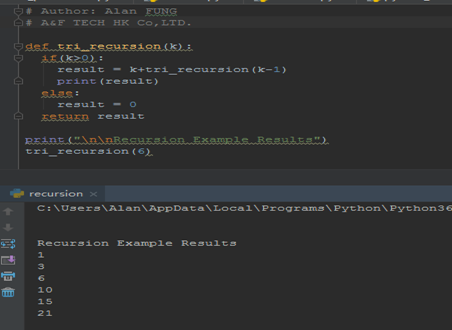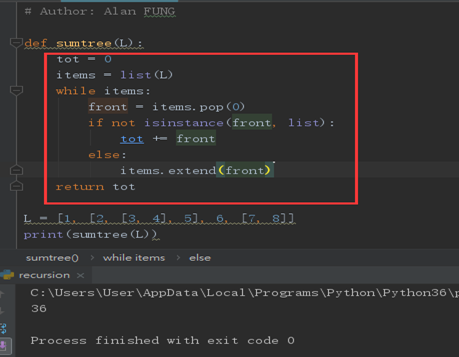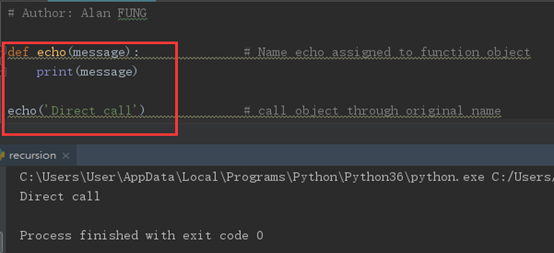Python Learning - Three
1. Set
Set is a collection which is unordered and unindexed. No duplicate members
In Python sets are written with curly brackets { }
set1 = {'apple', 'banana', 'cherry'}
list1 = [1, 2, 3, 4, 5]
list_set = set(list1)
print(set1)
print(list_set, type(list_set))
The set( ) constructor
# Note the double round-brackets
set_constructor = set(('apple', 'cherry', 'mango'))
print(set_constructor, type(set_constructor))
(1) .intersection( )
set1 = {'apple', 'banana', 'cherry'}
'''
list1 = [1, 2, 3, 4, 5]
list_set = set(list1)
'''
set2 = set(['mango', 'cherry', 'apple', 'orange'])
print(set1, set2)
print(set1.intersection(set2))
(2) .union( )
set1 = {'apple', 'banana', 'cherry'}
'''
list1 = [1, 2, 3, 4, 5]
list_set = set(list1)
'''
set2 = set(['mango', 'cherry', 'apple', 'orange'])
print(set1, set2)
print(set1.intersection(set2))
print(set1.union(set2))
(3) .difference( )
A.difference(B) means those values that are in A and not in B
# Author: Alan FUNG
# A&F TECH HK Co,LTD. set1 = {'apple', 'banana', 'cherry'} '''
list1 = [1, 2, 3, 4, 5]
list_set = set(list1)
''' set2 = set(['mango', 'cherry', 'apple', 'orange']) print(set1.difference(set2)) print(set2.difference(set1))
(4) .issubset( ) and .issuperset( )
set1 = {'apple', 'banana', 'cherry'}
'''
list1 = [1, 2, 3, 4, 5]
list_set = set(list1)
'''
set2 = set(['mango', 'cherry', 'apple', 'orange'])
print(set1.issubset(set2))
print(set1.issuperset(set2))
set3 = set(['apple', 'cherry'])
print(set3.issubset(set1))
print(set1.issuperset(set3))
(5) .symmetric_difference( )
set1 = {'apple', 'banana', 'cherry'}
'''
list1 = [1, 2, 3, 4, 5]
list_set = set(list1)
'''
set2 = set(['mango', 'cherry', 'apple', 'orange'])
print(set1.issubset(set2))
print(set1.issuperset(set2))
set3 = set(['apple', 'cherry'])
print(set3.issubset(set1))
print(set1.issuperset(set3))
print(set1.symmetric_difference(set3))
(6) .isdisjoint( )
# Return True if two sets have a null intersection
set1 = {'apple', 'banana', 'cherry'}
'''
list1 = [1, 2, 3, 4, 5]
list_set = set(list1)
'''
set2 = set(['mango', 'cherry', 'apple', 'orange'])
set3 = set(['apple', 'cherry'])
set4 = set(('mango', 'pineapple','orange' ))
print(set3.isdisjoint(set4))
(7) & and .intersection( )
et1 = {'apple', 'banana', 'cherry'}
'''
list1 = [1, 2, 3, 4, 5]
list_set = set(list1)
'''
set2 = set(['mango', 'cherry', 'apple', 'orange'])
set3 = set(['apple', 'cherry'])
set4 = set(('mango', 'pineapple','orange' ))
print(set1 & set2)
print(set1.intersection(set2))
print(set2.intersection(set1))
(8) | and .union( )
set1 = {'apple', 'banana', 'cherry'}
'''
list1 = [1, 2, 3, 4, 5]
list_set = set(list1)
'''
set2 = set(['mango', 'cherry', 'apple', 'orange'])
set3 = set(['apple', 'cherry'])
set4 = set(('mango', 'pineapple','orange' ))
print(set1 | set2)
print(set1.union(set2))
print(set2.union(set1))
(9) - and .difference( )
set1 = {'apple', 'banana', 'cherry'}
'''
list1 = [1, 2, 3, 4, 5]
list_set = set(list1)
'''
set2 = set(['mango', 'cherry', 'apple', 'orange'])
set3 = set(['apple', 'cherry'])
set4 = set(('mango', 'pineapple','orange' ))
print(set1 - set2)
print(set1.difference(set2))
print(set2-set1)
print(set2.difference(set1))
(10) ^ and .symmetric_difference( )
set1 = {'apple', 'banana', 'cherry'}
'''
list1 = [1, 2, 3, 4, 5]
list_set = set(list1)
'''
set2 = set(['mango', 'cherry', 'apple', 'orange'])
set3 = set(['apple', 'cherry'])
set4 = set(('mango', 'pineapple','orange' ))
print(set1 ^ set2)
print(set1.symmetric_difference(set2))
print(set2 ^ set1)
(11) .add ( )
set1 = {'apple', 'banana', 'cherry'}
'''
list1 = [1, 2, 3, 4, 5]
list_set = set(list1)
'''
set2 = set(['mango', 'cherry', 'apple', 'orange'])
set3 = set(['apple', 'cherry'])
set4 = set(('mango', 'pineapple','orange' ))
print(set3.add('mango'))
print(set3)
(12) .update( )
Add more than one item to the set
set1 = {'apple', 'banana', 'cherry'}
'''
list1 = [1, 2, 3, 4, 5]
list_set = set(list1)
'''
set2 = set(['mango', 'cherry', 'apple', 'orange'])
set3 = set(['apple', 'cherry'])
set4 = set(('mango', 'pineapple','orange' ))
print(set3.add('mango'))
print(set3)
set3.update(['pineapple', 'banana', 'orange'])
print(set3)
(13) .remove( )
et1 = {'apple', 'banana', 'cherry'}
'''
list1 = [1, 2, 3, 4, 5]
list_set = set(list1)
'''
set2 = set(['mango', 'cherry', 'apple', 'orange'])
set3 = set(['apple', 'cherry'])
set4 = set(('mango', 'pineapple','orange' ))
set4.remove('orange')
print(set4)
2. Files
The key function for working with files in Python is the open() function.
The open() function takes two parameters; filename, and mode.
There are four different methods (modes) for opening a file:
"r" - Read - Default value. Opens a file for reading, error if the file does not exist.
"a" - Append - Opens a file for appending, creates the file if it does not exist.
"w" - Write - Opens a file for writing, creates the file if it does not exist.
"x"- Create - Creates the specified file, returns an error if the file exists.
In addition, you can specify if the file should be handled as binary or text mode
"t" - Text - Default value. Text mode
"b"- Binary - Binary mode (e.g. images)
(1) "w"
file_w = open('testing_file', 'w', encoding='utf-8')

file_w = open('testing_file', 'w', encoding='utf-8')
file_w.write('Hello World! \n')
print(file_w)

(2) "a"
'''
file_w = open('testing_file', 'w', encoding='utf-8') file_w.write('Hello World! \n') print(file_w)
''' file_a = open('testing_file', 'a', encoding='utf-8') file_a.write('Hi, this is Alan \n') print(file_a)
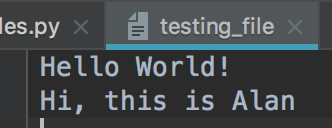
(3) "x"
file_x = open('testing_file', 'x', encoding='utf-8')

file_x = open('testing_file_for_create', 'x', encoding='utf-8')

file_x = open('testing_file_for_create_2', 'x', encoding='utf-8')
file_x.write('Hi, this is a new file')
print(file_x)


(4) .read( ) and .readline( )
1) .read( ) print all the content
file_read = open('testing_file', 'r', encoding='utf-8')
content = file_read.read()
print(content)
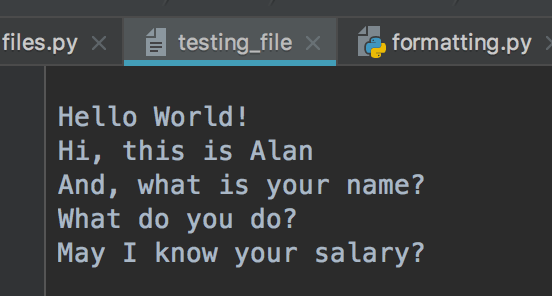
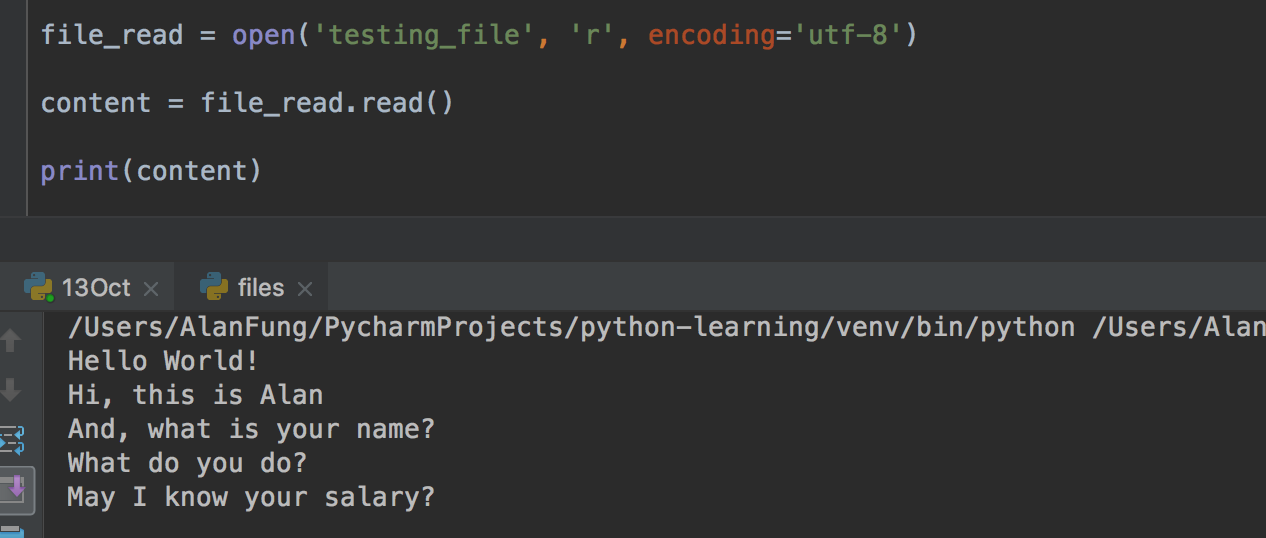
2) .readline( ) only return one line
file_read = open('testing_file', 'r', encoding='utf-8')
content = file_read.readline()
print(content)
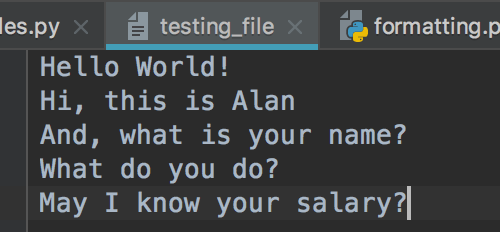
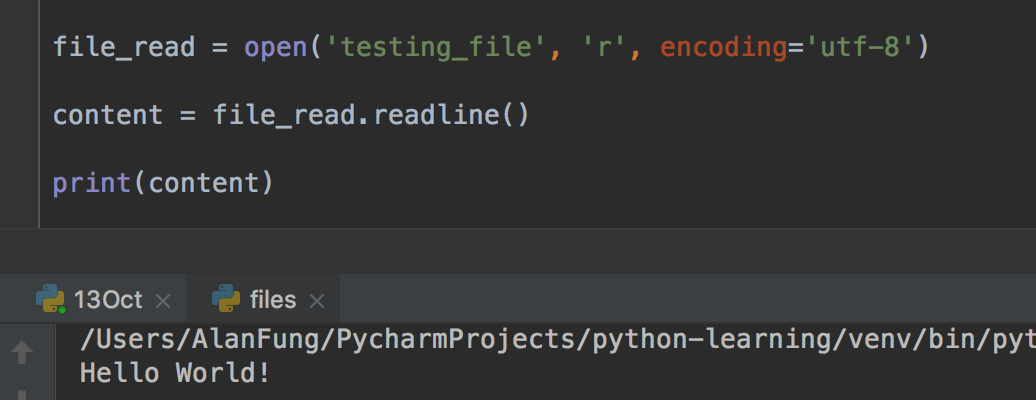
3) Use the for loop
file_read = open('testing_file', 'r', encoding='utf-8')
for i in range(5):
print(file_read.readline())
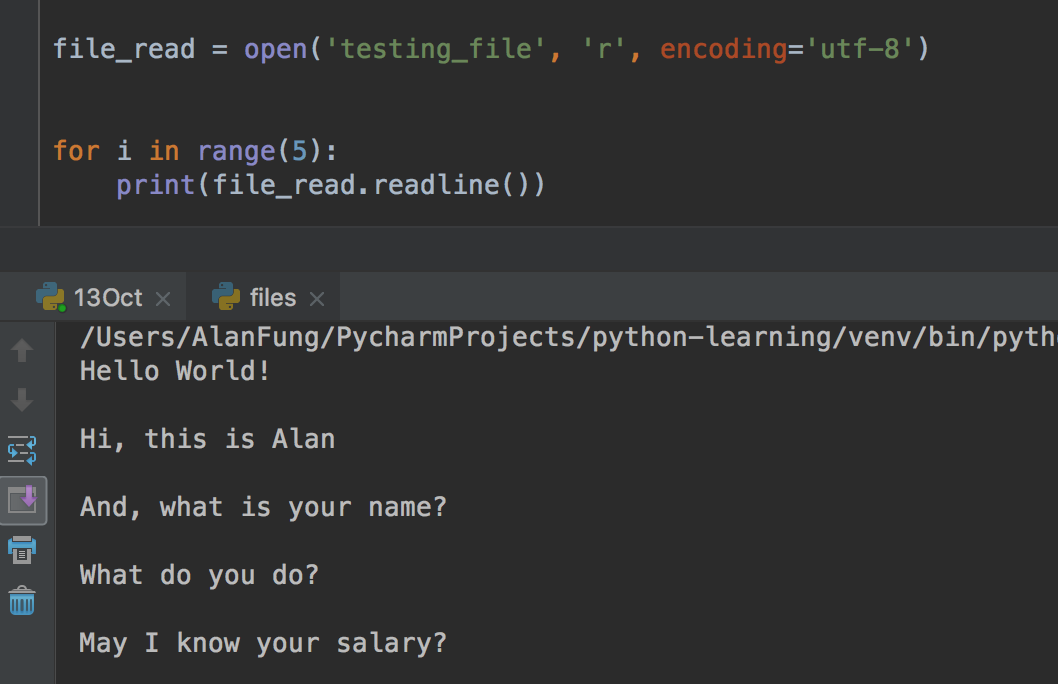
(5) .readline( ) and .readlines( )
1) .readlines( )
file_read = open('testing_file', 'r', encoding='utf-8')
for line in file_read.readlines():
print(line)

2) .readlines( ) with enumerate( )
file_read = open('testing_file', 'r', encoding='utf-8')
for index, line in enumerate(file_read.readlines()):
if index == 3:
print('-----------------------This is a dashline ----------------------------')
continue
print(line.strip())
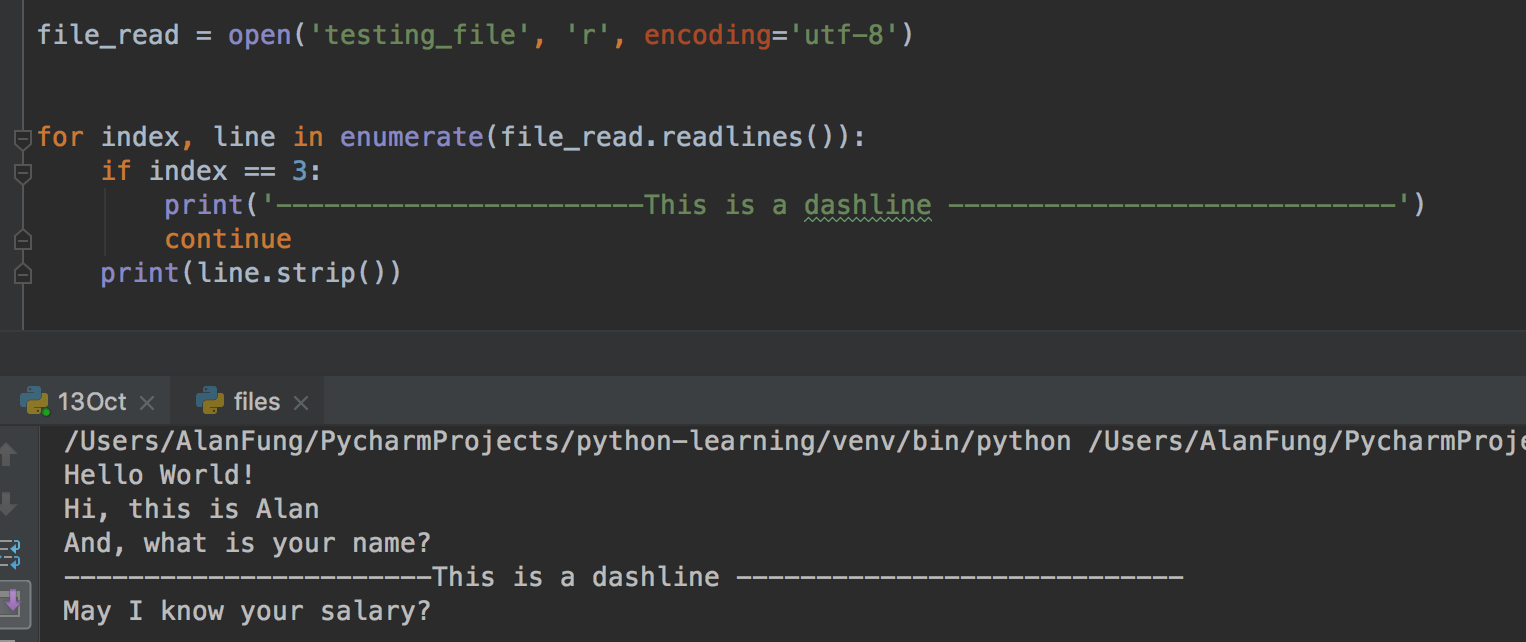
(6) .tell( )
file_read = open('testing_file', 'r', encoding='utf-8')
print(file_read.tell())
print(file_read.readline())
print(file_read.tell())
file_read.seek(0)
print(file_read.readline())
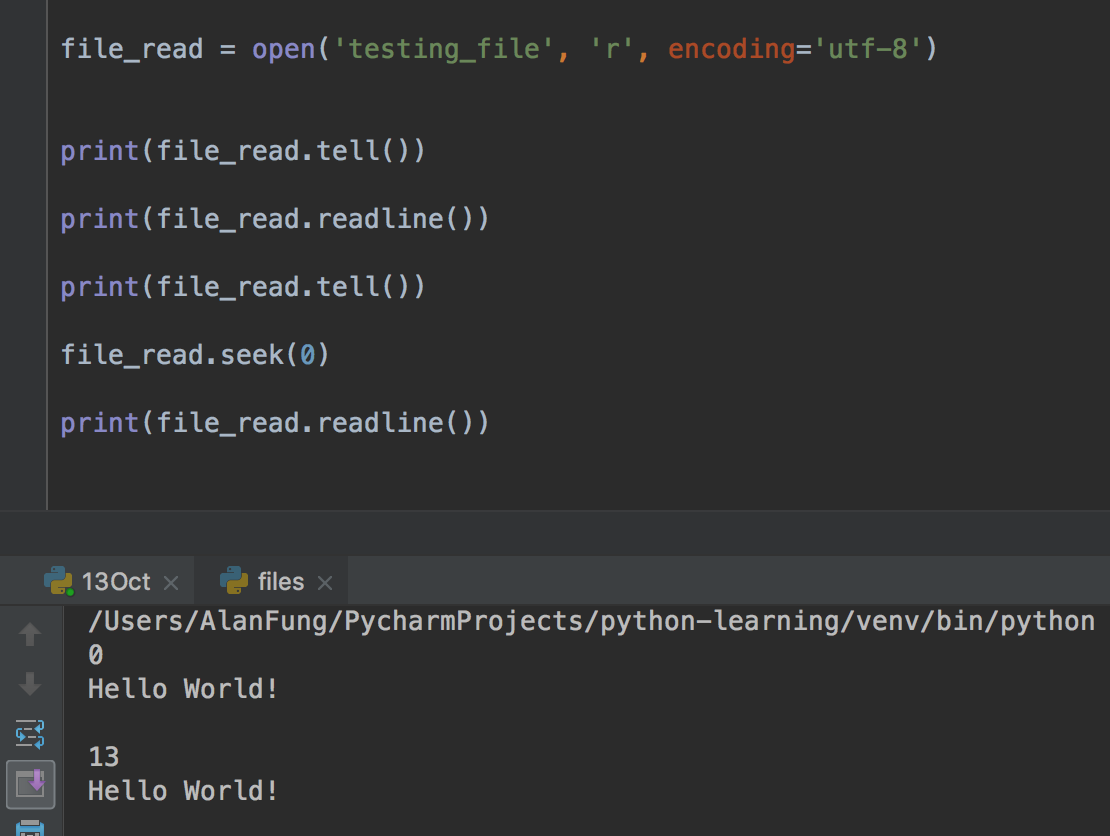
(7) .encoding( )
ile_read = open('testing_file', 'r', encoding='utf-8')
print(file_read.encoding)
(8) .flush( )
import sys, time
for i in range(20):
sys.stdout.write('#') sys.stdout.flush() time.sleep(0.5)
(9) read and write -- r+
ile_rwrite = open('testing_file', 'r+', encoding='utf-8')
print(file_rwrite.readline())
print(file_rwrite.readline())
print(file_rwrite.readline())
file_rwrite.write('--------------------- This is a dash line ----------------------')
print(file_rwrite.readline())

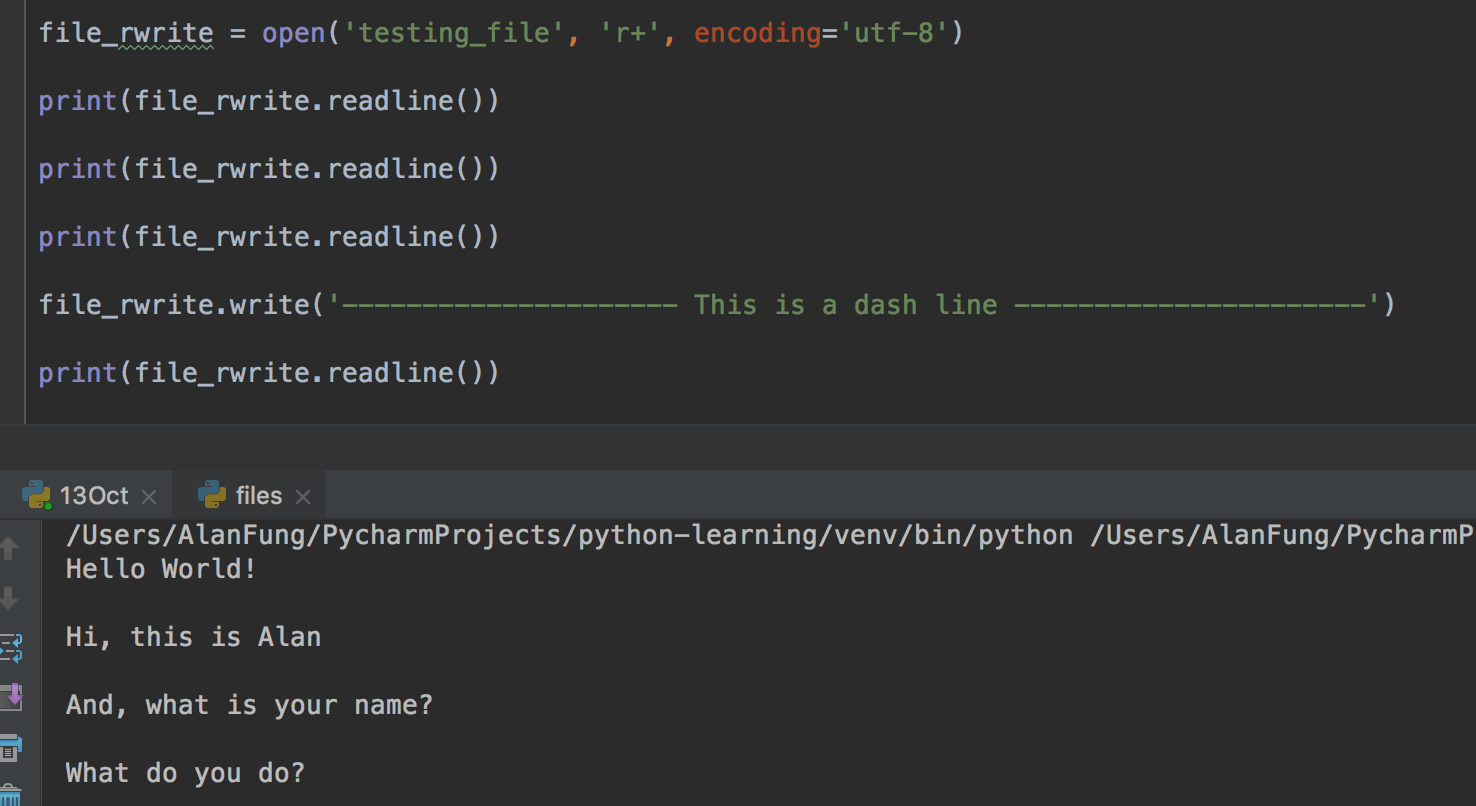
(10) Write and read -- w+
file_wread = open('testing_file', 'r+', encoding='utf-8')
file_wread.write('----------------------- This is a dash line -------------------------- \n')
file_wread.write('----------------------- This is a dash line -------------------------- \n')
file_wread.write('----------------------- This is a dash line -------------------------- \n')
file_wread.write('----------------------- This is a dash line -------------------------- \n')
print(file_wread.tell())
file_wread.seek(0)
print(file_wread.readline())
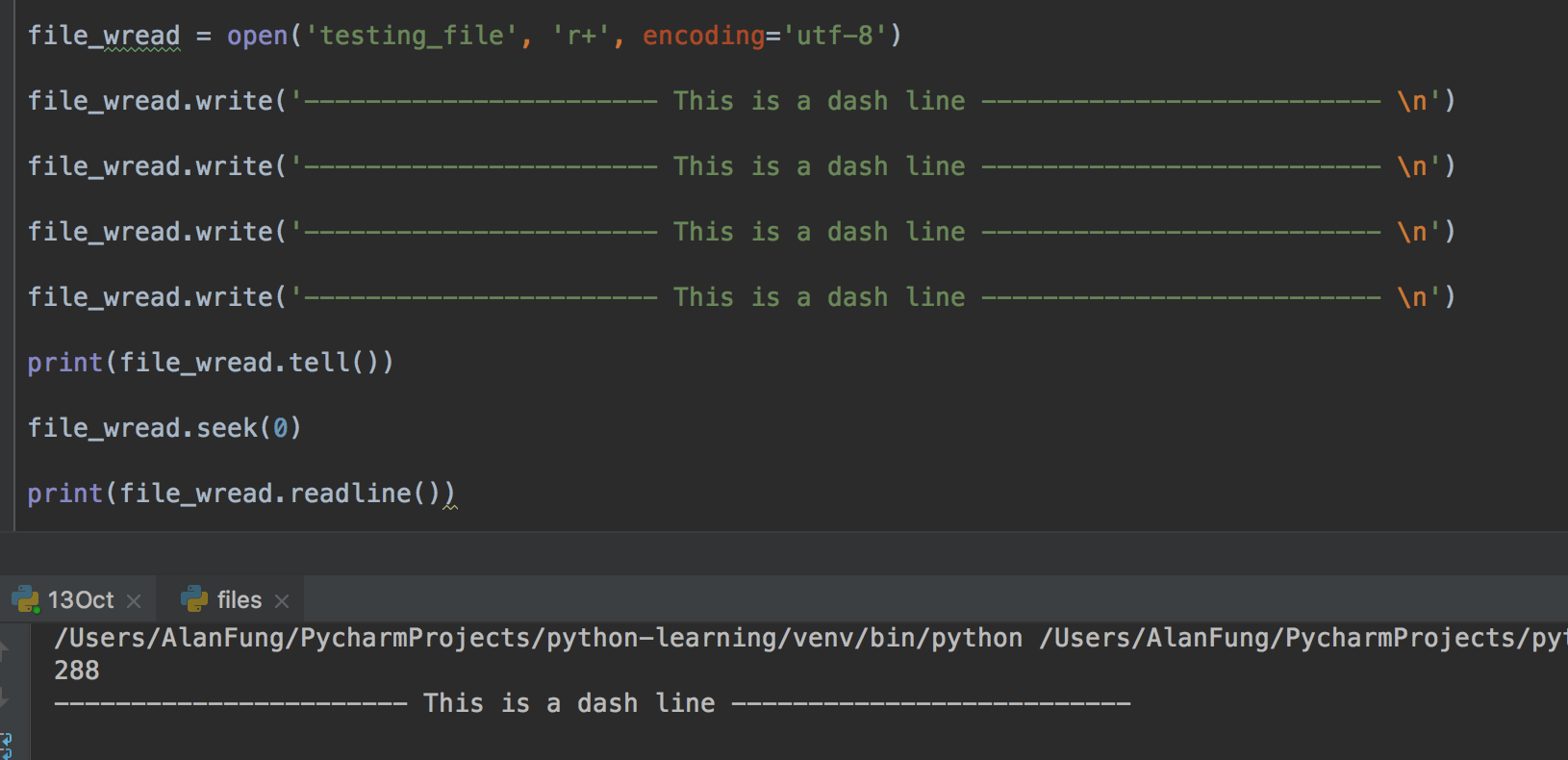
(11) file modification
file_mod = open('yesterday', 'r', encoding='utf-8')
file_new = open('yesterday_new.bak', 'w', encoding='utf-8')
for line in file_mod:
if 'Alan' in line:
line = line.replace('Alan','FUNG')
file_new.write(line)
else:
file_new.write(line)
file_mod.close()
file_new.close()

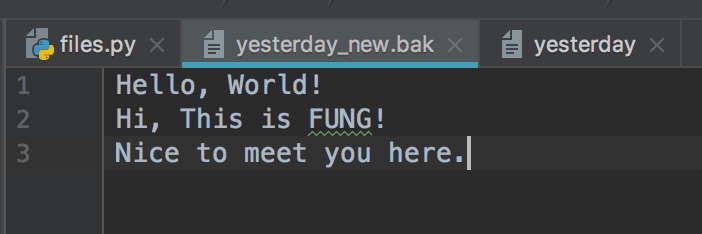
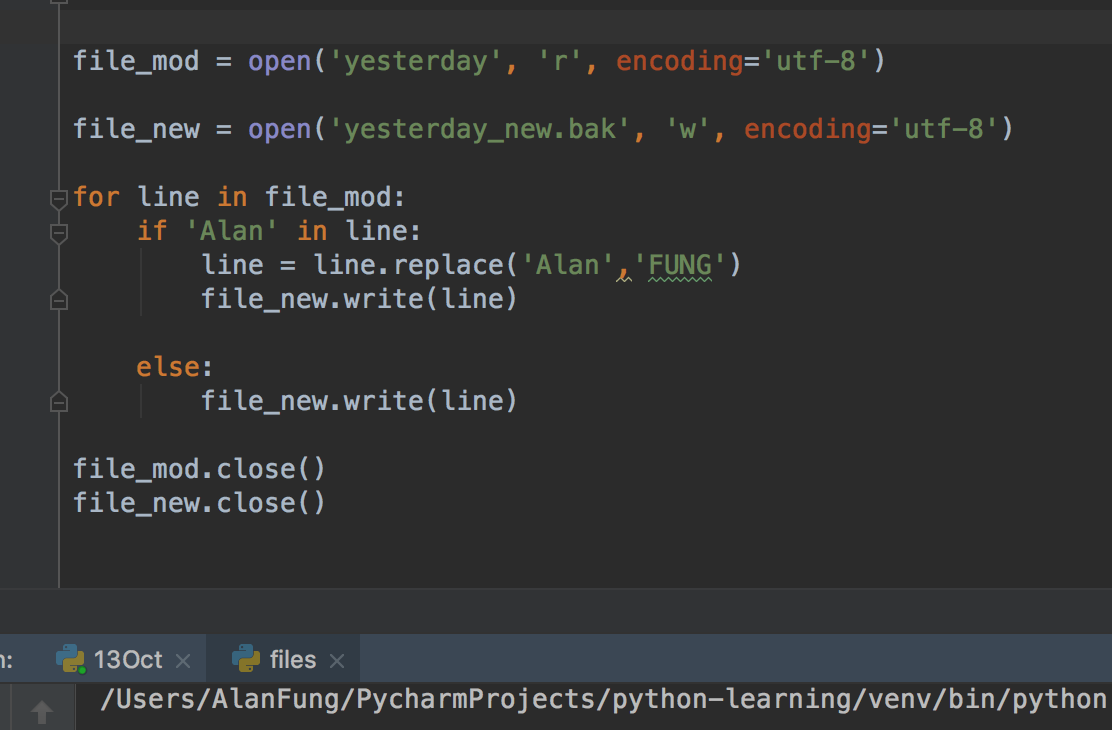
(12) with statement
with open('yesterday', 'r', encoding='utf-8') as file_read :
print(file_read.readline())

with open('yesterday', 'r', encoding='utf-8') as file_read :
for line in file_read:
print(line)

3. Python Functions
A function is a block of code which only runs when it is called.
You can pass data, known as parameters, into a function.
A function can return data as a result.
(1) Function Basics
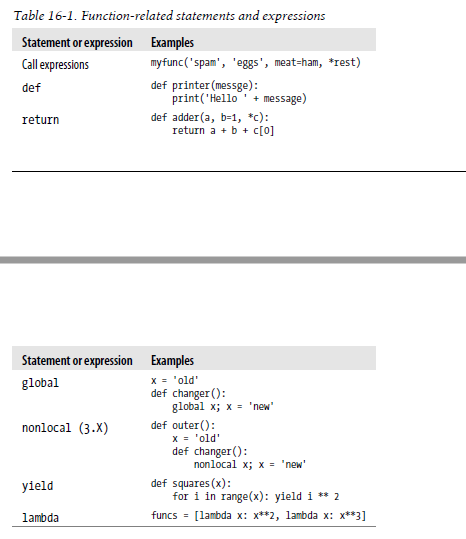
(2) Creating a Function
In Python a function is defined using the def keyword:


(3) Calling a Function
To call a function, use the function name followed by parenthesis:
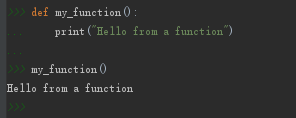
(4) Parameters
Information can be passed to functions as parameter.
Parameters are specified after the function name, inside the parentheses. You can add as many parameters as you want, just separate them with a comma.
The following example has a function with one parameter (fname). When the function is called, we pass along a first name, which is used inside the function to print the full name:
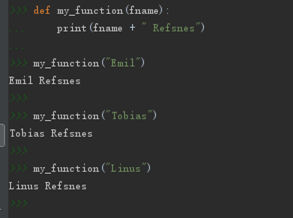
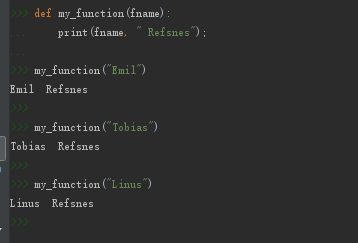
(5) Default Parameter Value
The following example shows how to use a default parameter value.
If we call the function without parameter, it uses the default value:
Default Value:

def my_function(country = "Norway"):
print("I am from " + country) my_function() my_function("Hong Kong")


(6) Multiple Arguments
Asterisk ['æstərɪsk] 星號, 星號鍵 Multiple Arguments

The asterisk * means multiple arguments. Receive positional parameters (位置參數), and convert into tuples. Positional parameters must be placed before the keyword parameters.
def test(*args):
print(args) test(1,2,3,4,5,6) test(*[1,2,3,4,5,6])

1) ** == > dictionay
Receive keyword parameters (關鍵字參數) and Convert into dictionary.
def test2(**kwargs):
print(kwargs) test2(name = "alan", age = 28, gender = 'male') test2(**{'name':'alan', 'age':28, 'gender': 'male'})
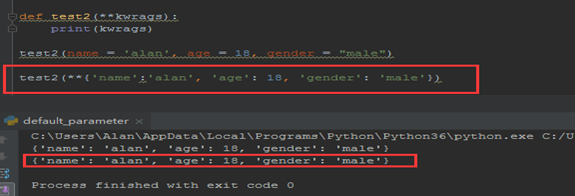
def test2(**kwargs):
print(kwargs)
print(kwargs['name']) test2(name = "alan", age = 28, gender = 'male') test2(**{'name':'alan', 'age':28, 'gender': 'male'})

def test3(name, **kwargs):
print(name)
print(kwargs)
test3('alan')
test3("alan", age = 28, gender = 'male')
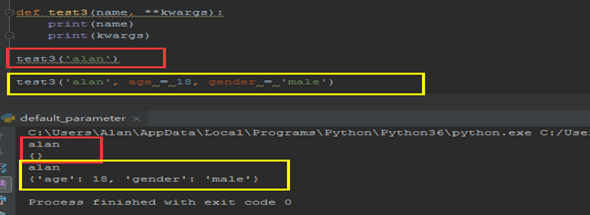
def test4(name, age = 18, *args, **kwargs):
print(name)
print(age)
print(args)
print(kwargs)
test4('Alan', 27, gender = 'malre', jod = 'analyst')
def test4(name, age = 18, *args, **kwargs):
print(name)
print(age)
print(args)
print(kwargs)
test4('Alan', 27, 23,4,54, 76, gender = 'malre', jod = 'analyst')

def logger(source):
print('From {}'.format(source))
print("From %s" %(source)) def test4(name, age = 18, *args, **kwargs):
print(name)
print(age)
print(args)
print(kwargs)
logger('TEST-4') test4('Alan', 28, gender = 'male', job = 'analyst')
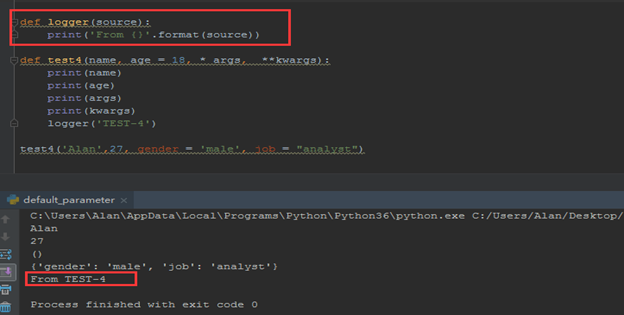
(7) Return Values (返回值)
To let a function to return a value, use the return statement:
def my_function(x):
return x * 5 print(my_function(3)) print(my_function(5)) print(my_function(9))
def my_function(x):
print(x * 5) my_function(3) print(my_function(3))
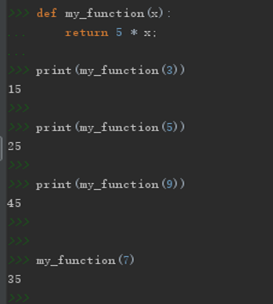 VS
VS 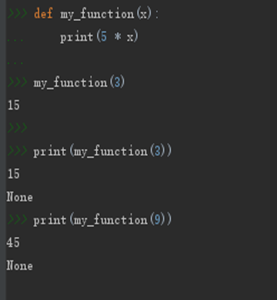
def func1():
print("This is a function!") def func2():
print('This is another function!')
return 0 def func3():
print('This is also a function!')
return 1, 'function', ['alan', 'fung'], {'Name': 'AlanFUNG'} func1()
print(func1())
func2()
print(func2())
func3()
print(func3())
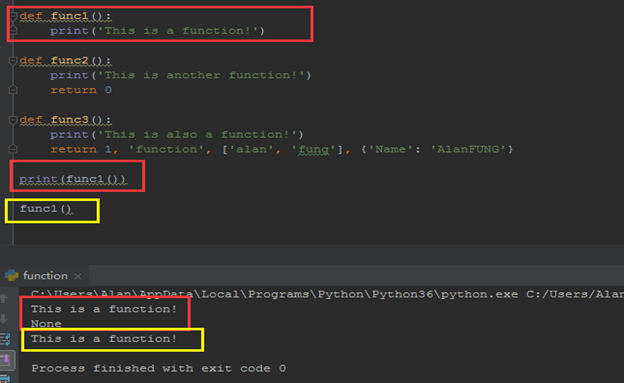

(8) Scopes
1) Python Scope Basics
Besides packaging code for reuse, functions add an extra namespace layer to your programs to minimize the potential for collisions among variables of the same name—by default, all names assigned inside a function are associated with that function’s namespace, and no other. This rule means that:
- Names assigned inside a def can only be seen by the code within that def. You cannot even refer to such names from outside the function.
- Names assigned inside a def do not clash with variables outside the def, even if the same names are used elsewhere. A name X assigned outside a given def (i.e., in a different def or at the top level of a module file) is a completely different variable from a name X assigned inside that def.
Variables may be assigned in three different places, corresponding to three different scopes:
- If a variable is assigned inside a def, it is local to that function.
- If a variable is assigned in an enclosing def, it is nonlocal to nested functions.
- If a variable is assigned outside all defs, it is global to the entire file.
Scope Example
# global scope
X = 99 # X and func assigned in module: global def func(Y): #Y and Z assigned in function: locals
# local scope
Z = X + Y # X is a global
return Z print(func(1))
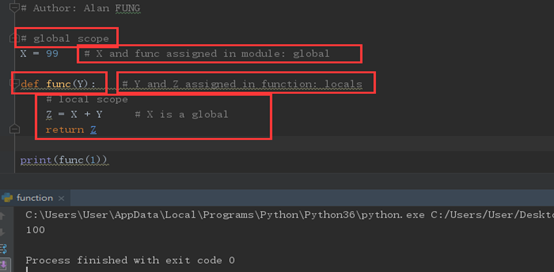
The Built-in Scope
import builtins
print(dir(builtins)) print(zip) print(zip is builtins.zip)

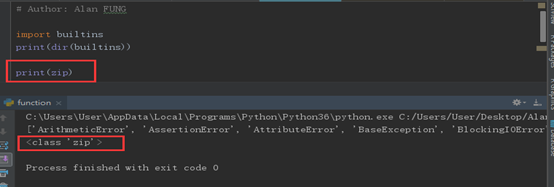
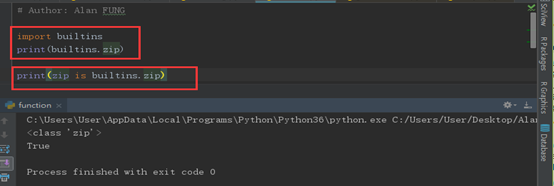
2) The global Statement
We’ve talked about global in passing already. Here’s a summary:
- Global names are variables assigned at the top level of the enclosing module file.
- Global names must be declared only if they are assigned within a function.
- Global names may be referenced within a function without being declared
X = 88
def func():
global X
X = 99 print(func()) print(X)
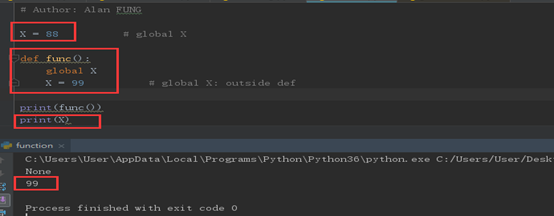
Program Design: Minimize Global Variables
X = 99
def func1():
global X
X = 88 def func2():
global X
X = 77 print(func1())
print(X) print(func2())
print(X)
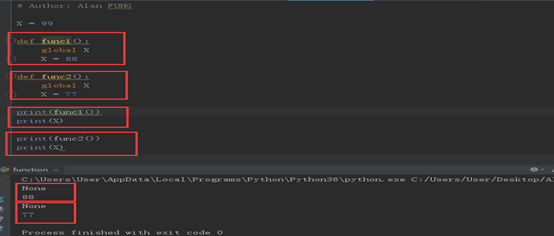
(9) Recursion
Python also accepts function recursion, which means a defined function can call itself.
Recursion is a common mathematical and programming concept. It means that a function calls itself. This has the benefit of meaning that you can loop through data to reach a result.
The developer should be very careful with recursion as it can be quite easy to slip into writing a function which never terminates, or one that uses excess amounts of memory or processor power. However, when written correctly recursion can be a very efficient and mathematically-elegant approach to programming.
In this example, tri_recursion() is a function that we have defined to call itself ("recurse"). We use the k variable as the data, which decrements (-1) every time we recurse. The recursion ends when the condition is not greater than 0 (i.e. when it is 0).
To a new developer it can take some time to work out how exactly this works, best way to find out is by testing and modifying it.
def tri_recursion(k):
if (k > 0):
result = k + tri_recursion(k-1)
print(result)
else:
result = 0
return result print("\n\n Recursion Example Results")
tri_recursion(6)
1) Recursive Functions
Summation with Recursion
def mysum(L):
if not L:
return 0
else:
return L[0] + mysum(L[1:]) # Call myself recursively print(mysum([1,2,3,4,5]))

def mysum(L):
print(L)
if not L:
return 0
else:
return L[0] + mysum(L[1:]) # Call myself recursively print(mysum([1,2,3,4,5]))
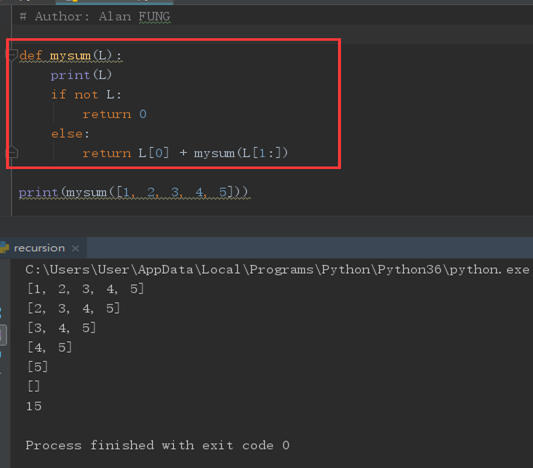
Coding Alternatives
def mysum(L):
return 0 if not L else L[0] + mysum(L[1:]) print(mysum([1])) print(mysum([1,2,3,4,5]))
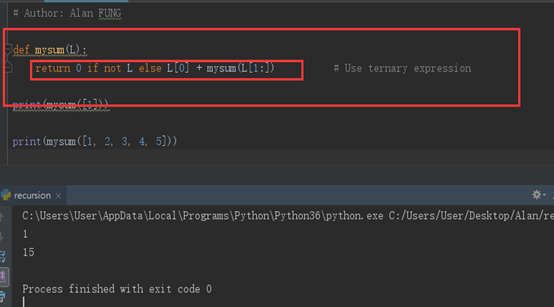
def mysum(L):
if not L: return 0
return nonempty(L) def nonempty(L):
return L[0] + mysum(L[1:]) print(mysum([1,2,3,4,5]))
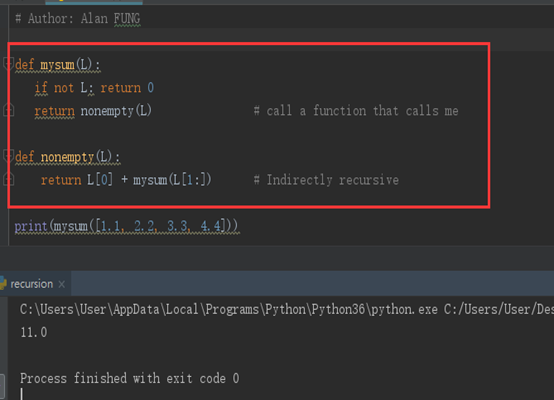
Loop Statements Versus Recursion
L = [1,2,3,4,5]
sum = 0
while L:
sum += L[0]
L = L[1:] print(sum)
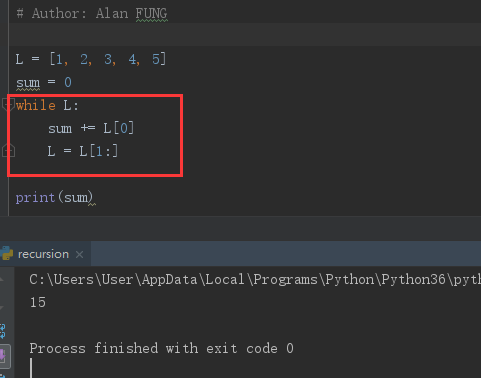
L = [1,2,3,4,5]
sum = 0
for x in L: sum += x
# sum += x print(sum)

Handling Arbitrary Structures
def sumtree(L):
tot = 0
for x in L:
if not isinstance(x,list):
tot += x
else:
tot += sumtree(x)
return tot L = [1, [2, [3,4], 5], 6, [7, 8]] print(sumtree(L))
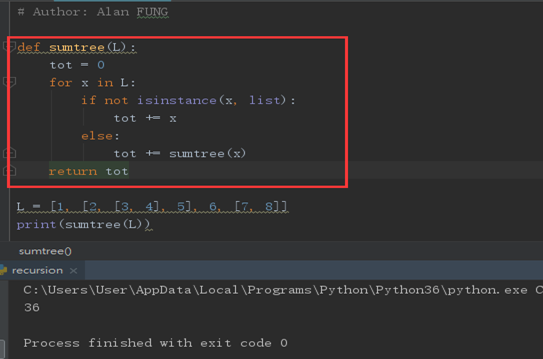
Recursion versus queues and stacks
def sumtree(L):
tot = 0
items = list(L)
while items:
front = items.pop(0)
if not isinstance(front, list):
tot += front
else:
items.extend(front)
return tot L = [1, [2, [3,4], 5], 6, [7, 8]] print(sumtree(L))
4 Function Objects: Attributes and Annotations
(1) Indirect Function Calls: “First Class” Objects
def echo(message):
print(message) echo("Direct Call")
def echo(message):
print(message) x = echo
x("Indirect Call")
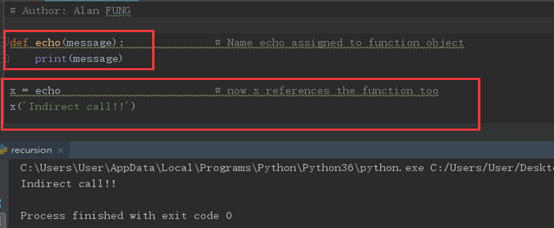
def echo(message):
print(message) def indirect(func, arg):
func(arg) indirect(echo, 'Argument Calls!')
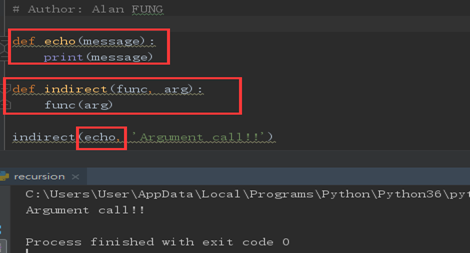
def echo(message):
print(message) schedule = [(echo, 'Spam!'), (echo, 'Ham!')] for (func, arg) in schedule:
func(arg)
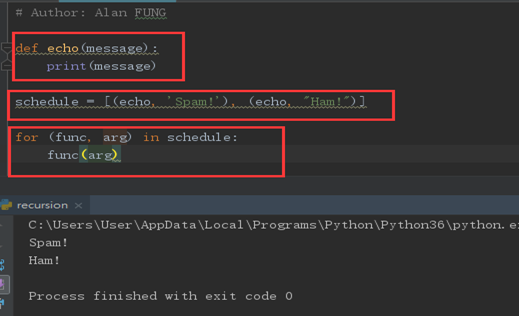
def make(label):
def echo(message):
print(label + " :" + message)
print(label, ":", message)
return echo F = make("Spam") F("Ham!") F("Eggs!")
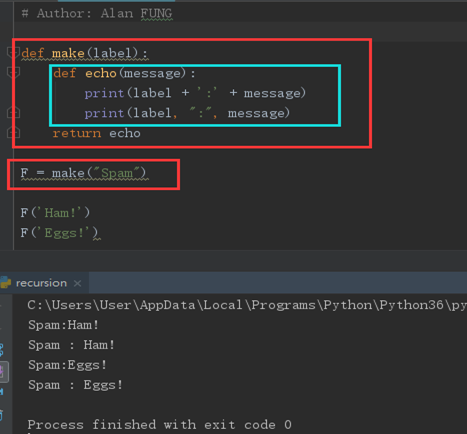
(2) Function Introspection
def func(a):
b = "spam"
return b * a print(func(8))

def func(a):
b = "spam"
return b * a print(func.__name__) print(dir(func)) print(func.__code__) print(dir(func.__code__)) print(func.__code__.co_varnames) print(func.__code__.co_argcount)
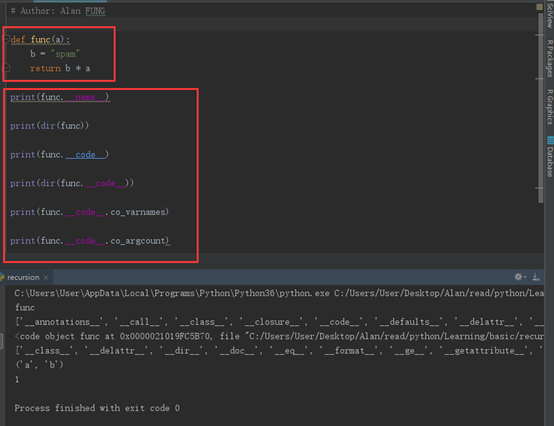
(3) Function Attributes
def func(a):
b = "spam" return b * a print(func)
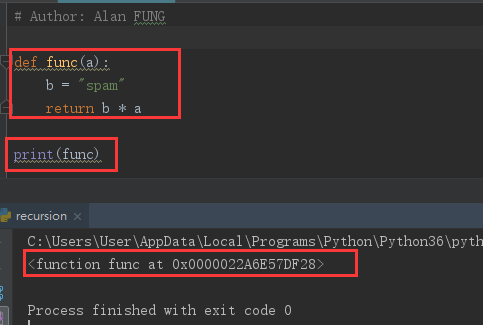
def func(a):
b = "spam" return b * a
print(func) func.count = 0 func.count += 1 print(func.count) func.handles = "Button-press" print(func.handles) print(dir(func))
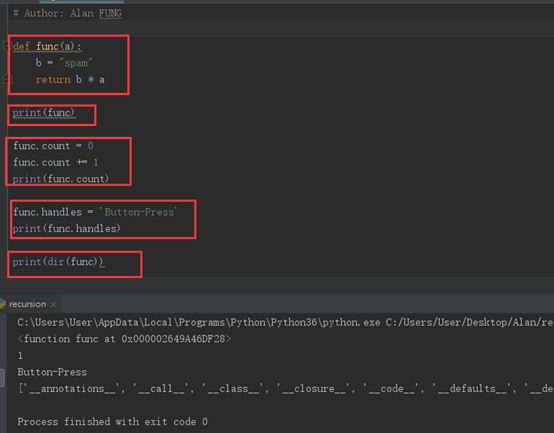
def f(): pass print(dir(f)) print(len(dir(f)))
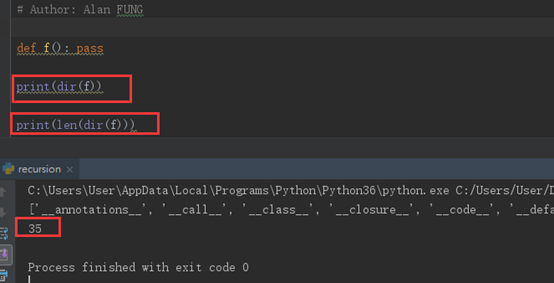
(4) Function Annotations in 3.X
def func(a, b, c):
return a + b + c print(func(1, 2, 3))

def func(a:'spam', b:(1,10), c:float) ->int:
return a + b + c print(func(1, 2, 3))
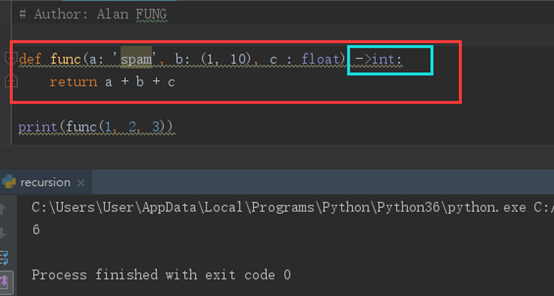
5. Anonymous Functions: lambda
(1) lambda Basics
Besides the def statement, Python also provides an expression form that generates function objects. Because of its similarity to a tool in the Lisp language, it’s called lambda.
The lambda’s general form is the keyword lambda, followed by one or more arguments (exactly like the arguments list you enclose in parentheses in a def header), followed by an expression after a colon:
lambda argument1, argument2, ... argumentN : expression using arguments
- lambda is an expression, not a statement.
- lambda’s body is a single expression, not a block of statements.
def func(x, y, z):
return x + y + z print(func(2, 3, 4)) f = lambda x, y, z : x + y + z print(f(2,3,4))
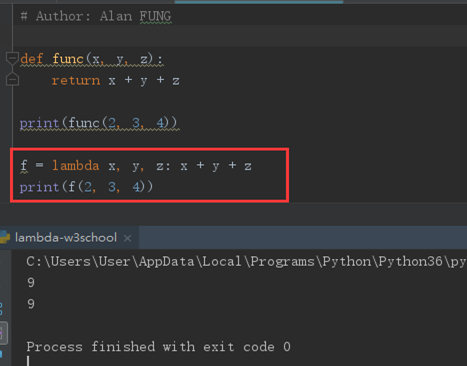
x = lambda a = "fee", b = "fie", c = "foe": a + b + c
y = (lambda a = "fee", b = "fie", c = "foe": a + b + c) print(x("wee"))
print(y(b ="wee"))
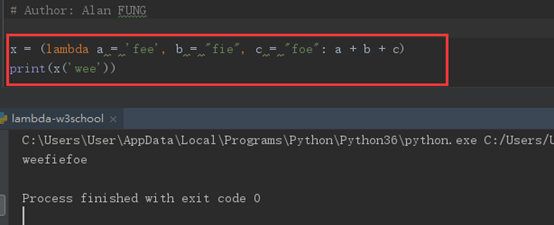
def knights():
title = "sir"
action = (lambda x : title + ' ' + x)
return action act = knights()
msg = act('robin')
print(msg)

(2) Scopes: lambdas Can Be Nested Too
def action(x):
return (lambda y: x + y) act = action(99)
print(act) print(act(2))

action = (lambda x: (lambda y: x + y)) act = action(99) print(act(3)) print((lambda x: (lambda y: x + y))(99)(4))
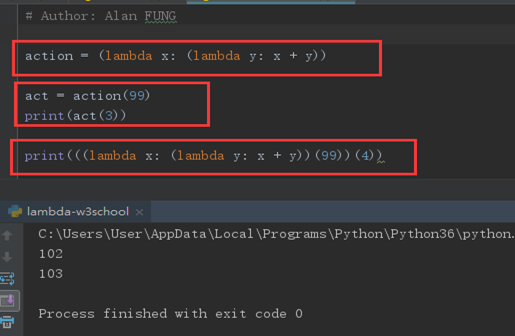
6. Functional Programming Tools
(1) Mapping Functions over Iterables: map
counters = [1, 2, 3, 4] updated = [] for x in counters:
updated.append(x + 10) print(updated)
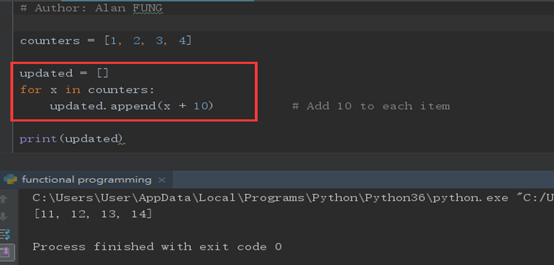
counters = [1, 2, 3, 4]
def inc(x): return x + 10 print(list(map(inc, counters)))
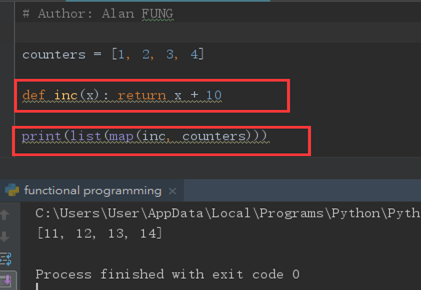
counters = [1, 2, 3, 4] print(list(map((lambda x: x + 3), counters)))
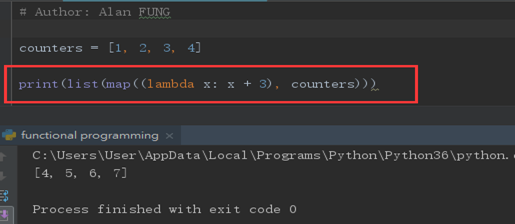
def inc(x): return x + 10 def mymap(func, seq):
res = []
for x in seq: res.append(func(x))
return res print(list(map(inc, [1, 2, 3])))
print(mymap(inc, [1, 2, 3]))
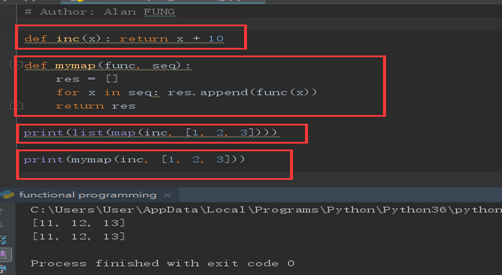
print(pow(3,4)) print(list(map(pow,[1,2,3], [2,3, 4])))
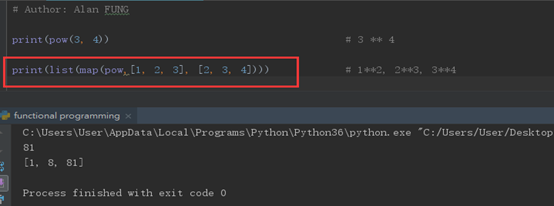
def inc(x): return x + 10 print(list(map(inc, [1, 2, 3, 4]))) print([inc(x) for x in [1, 2, 3, 4]]) print(list(inc(x) for x in [1, 2, 3, 4]))
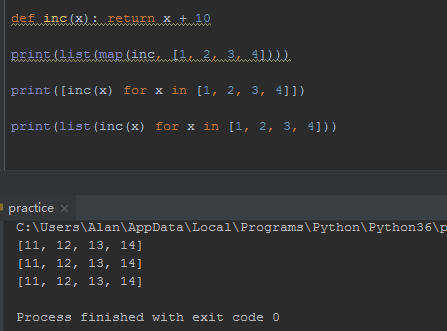
(2) Selecting Items in Iterables: filter

print(list(range(-5, 5))) print(list(filter((lambda x: x > 0), range(-5, 5))))
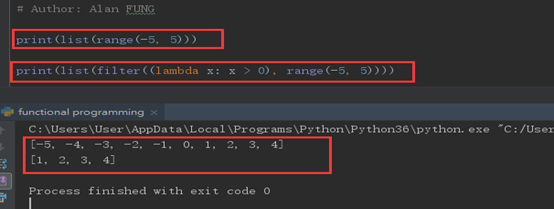
res = [] for x in range(-5, 5):
if x > 0:
res.append(x) print(res) print([x for x in range(-5, 5) if x > 0])
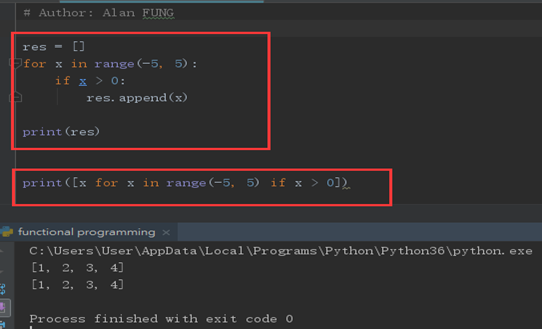
(3) Combining Items in Iterables: reduce
from functools import reduce # import in 3.x, not in 2.x print(reduce((lambda x, y: x + y), [1,2,3,4])) print(reduce((lambda x, y: x * y), [2,3,4,5])) L = [1, 2, 3, 4]
res = L[0]
for x in L[1:]:
res = res + x
print(res)
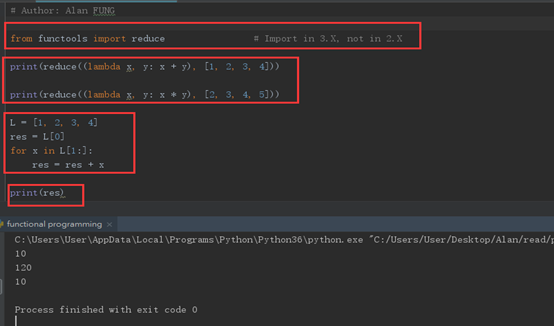
Coding your own version of reduce is actually fairly straightforward. The following function emulates most of the built-in’s behavior and helps demystify its operation in general:
def myreduce (function, sequence):
tally = sequence[0] for next in sequence[1:]:
tally = function(tally, next) return tally print(myreduce((lambda x, y : x + y), [1,2,3,4,5])) print(myreduce((lambda x, y : x * y), [1,2,3,4,5]))
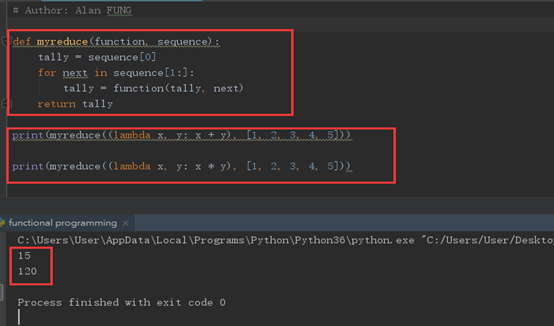
import operator, functools print(functools.reduce(operator.add,[2,4,6])) print(functools.reduce((lambda x, y: x + y), [2,4,6]))
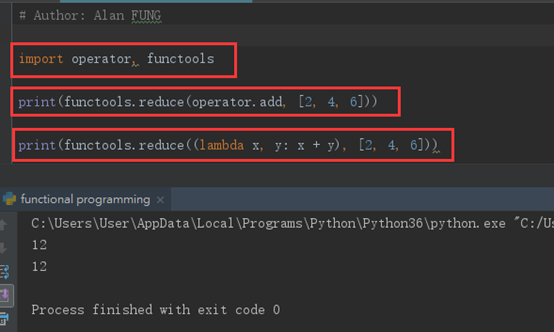
Python Learning - Three的更多相关文章
- python learning Exception & Debug.py
''' 在程序运行的过程中,如果发生了错误,可以事先约定返回一个错误代码,这样,就可以知道是否有错,以及出错的原因.在操作系统提供的调用中,返回错误码非常常见.比如打开文件的函数open(),成功时返 ...
- Python Learning Paths
Python Learning Paths Python Expert Python in Action Syntax Python objects Scalar types Operators St ...
- Python Learning
这是自己之前整理的学习Python的资料,分享出来,希望能给别人一点帮助. Learning Plan Python是什么?- 对Python有基本的认识 版本区别 下载 安装 IDE 文件构造 Py ...
- How to begin Python learning?
如何开始Python语言学习? 1. 先了解它,Wiki百科:http://zh.wikipedia.org/zh-cn/Python 2. Python, Ruby等语言来自开源社区,社区的学法是V ...
- Experience of Python Learning Week 1
1.The founder of python is Guido van Rossum ,he created it on Christmas in 1989, smriti of ABC langu ...
- Python Learning: 03
An inch is worth a pound of gold, an inch of gold is hard to buy an inch of time. Slice When the sca ...
- Python Learning: 02
OK, let's continue. Conditional Judgments and Loop if if-else if-elif-else while for break continue ...
- Python Learning: 01
After a short period of new year days, I found life a little boring. So just do something funny--Py ...
- Python Learning - Two
1. Built-in Modules and Functions 1) Function def greeting(name): print("Hello,", name) g ...
随机推荐
- Window10系统中MongoDB数据库导入数据文件
首先进入C:\Program Files\MongoDB\Server\4.0\bin> 打开cmd 创建一个空的数据库集合 db.createCollection("myColl ...
- springboot上传文件 & 不配置虚拟路径访问服务器图片 & springboot配置日期的格式化方式 & Springboot配置日期转换器
1. Springboot上传文件 springboot的文件上传不用配置拦截器,其上传方法与SpringMVC一样 @RequestMapping("/uploadPicture&q ...
- ModuleNotFoundError: No module named 'video_back.urls'
新建Django项目时将settings,urls移除来时报错. 这是我所想要的项目结构 >>> 扁平结构. 将下面这个应用的名字删掉就可以了.
- Haystack-全文搜索框架
Haystack 1.什么是Haystack Haystack是django的开源全文搜索框架(全文检索不同于特定字段的模糊查询,使用全文检索的效率更高 ),该框架支持Solr,Elasticsear ...
- 微信支付没有结果通知,notify_url参数的接口没有收到微信支付结果通知
在微信支付统一下单的时候需要填一个notify_url参数用于处理微信支付结果通知 但是,有时候我们发现我们设置的这个接口收不到微信请求.原因有一下几个,大家一一对照,也欢迎补充. 1. url是否可 ...
- docker 安装mysql数据库 <二>
一.下载mysql数据库 #网易镜像中心https://c.163.com/hub#/m/home/ #采用网易加速地址,不加速时下载非常的慢 docker pull hub.c..com/libra ...
- 一篇图看清Java中的各种Queue
说到数据结构,我们大概可以列出这么几个:数组,链表,栈,队列,集合,哈希表. 其中 队列 作为一个常用的数据结构,在Java中也有各种形式的实现. 顶级接口为java.util.queue. java ...
- MyString
[摘自C++程序设计语言] MyString.h #include <cstring> #include <iostream> #include <stdexcept&g ...
- 快速搭建MQTT服务器(MQTTnet和Apache Apollo)
前言 MQTT协议是IBM开发的一个即时通讯协议,有可能成为物联网的重要组成部分,http://mqtt.org/. MQTT is a machine-to-machine (M2M)/" ...
- Linux下如何查看系统启动时间和运行时间以及安装时间
1.uptime命令输出:16:11:40 up 59 days, 4:21, 2 users, load average: 0.00, 0.01, 0.00 2.查看/proc/uptime文件计算 ...

